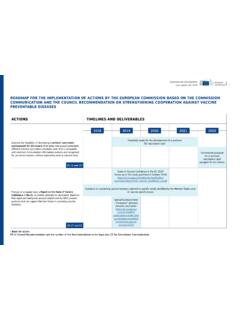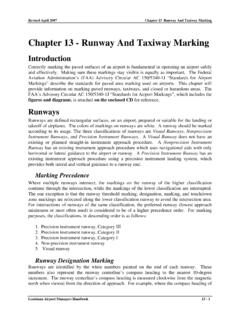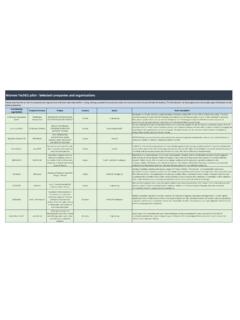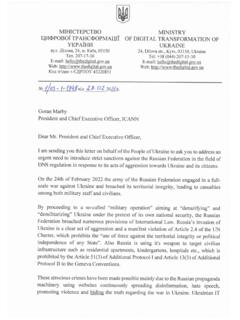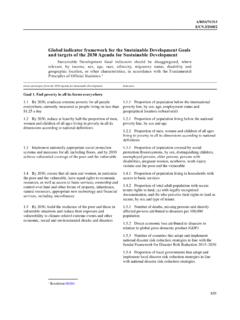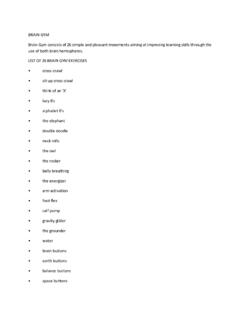Transcription of EU GENDER ACTION PLAN III - European Commission
1 EU GENDER ACTION plan III AN AMBITIOUS AGENDA FOR GENDER EQUALITY AND WOMEN S EMPOWERMENT IN EU EXTERNAL ACTION EN EN European Commission HIGH REPRESENTATIVE OF THE UNION FOR FOREIGN AFFAIRS AND SECURITY POLICY Brussels, JOIN(2020) 17 final JOINT COMMUNICATION TO THE European PARLIAMENT AND THE COUNCIL EU GENDER ACTION plan (GAP) III AN AMBITIOUS AGENDA FOR GENDER EQUALITY AND WOMEN S EMPOWERMENT IN EU EXTERNAL ACTION {SWD(2020) 284 final} EN EN European Commission HIGH REPRESENTATIVE OF THE UNION FOR FOREIGN AFFAIRS AND SECURITY POLICY Brussels, JOIN(2020) 17 final JOINT COMMUNICATION TO THE European PARLIAMENT AND THE COUNCIL EU GENDER ACTION plan (GAP) III AN AMBITIOUS AGENDA FOR GENDER EQUALITY AND WOMEN S EMPOWERMENT IN EU EXTERNAL ACTION {SWD(2020) 284 final} 2 JOINT COMMUNICATION GAP IIIEU GENDER ACTION plan (GAP) III AN AMBITIOUS AGENDA FOR GENDER EQUALITY AND WOMEN S EMPOWERMENT IN EU EXTERNAL ACTION Gender1 equality is a core value of the EU2 and a universally recognised human right, as well as an imperative to well-being, economic growth, prosperity, good governance, peace and security.
2 All people, in all their diversity, should be free to live their chosen life, thrive socially and economically, participate and take a lead as equals. The EU is a global front-runner in promoting GENDER equality as a key political objective of its external ACTION and common foreign and security policy, aimed at accelerating progress towards global goals including the Sustainable Development Goals (SDG) at the core of the 2030 Agenda. The EU pursues a three-pronged approach, combining GENDER mainstreaming, targeted actions and political challenges to GENDER equality are as varied as the contexts in which they emerge and call for context specific responses.
3 There is, however, not a single country in the world that is close to achieving by 2030 GENDER equality and empowerment of all women and girls. In 2020, it is 25 years since the Beijing Declaration and Platform for Action3 and 20 years since UN Security Council Resolution 1325 on Women, Peace and Security4 were adopted. Some progress has been achieved, but deep-rooted inequalities persist, including on basic access to health, education and jobs, but also with regards to widespread GENDER -based violence everywhere in the world. In many places, women s and girls rights are called into question and often denied. Instability, fragility, conflict, climate change, environmental degradation, migration, forced displacement and lately the COVID-19 pandemic are among the critical factors exacerbating inequalities and threatening hard-won gains.
4 Civil society organisations, including women s rights organisations, are facing shrinking civil, civic and democratic , challenges also bring opportunities. Women and girls increasingly take part in shaping global transformations, with new generations active in global and grassroots movements for a green and just transition, equal rights for all, democracy, and for peaceful and inclusive societies. This shows that positive change is possible. The post-COVID-19 recovery must be an opportunity to address structural inequalities and build more inclusive societies. Drawing from the EU GENDER equality strategy 2020 - 2025, which calls for a GENDER -equal Europe, this new EU GENDER ACTION plan for 2021 2025 (GAP III) calls for a GENDER -equal world and is complementary to the LGBTIQ equality strategy for 2020-2025.
5 It will scale up the EU contribution to reach SDG 55 in all EU internal and external policy areas and across the 2030 Agenda. 1 GENDER means the socially constructed roles, behaviours, activities and attributes that a given society considers appropriate for women and men. 2 Art. 2, 3(3) and 21 of the Treaty on the European Union (TEU), Art. 8 of the Treaty on the Functioning of the European Union (TFEU), and Art. 21 and 23 of the EU Charter of Fundamental 3 GENDER ACTION plan IIIB uilding on the evaluation of EU support to GENDER equality6 and stakeholder consultations7, GAP III provides a policy framework for the EU to boost its level of engagement, focusing on five pillars:1.
6 Making EU engagement on GENDER equality more effective as a cross-cutting priority of EU external ACTION in its policy and programming work. The European Commission and the High Representative reconfirm that by 2025 85% of all new external actions will contribute to this objective8. This requires further GENDER mainstreaming in all external policies and sectors and a GENDER -transformative9, rights-based and intersectional10 approach. 2. Promoting, together with EU Member States, strategic EU engagement at multilateral, regional and country level and jointly stepping up implementation of GAP III in each partner country and region, in close cooperation with partner governments, civil society, the private sector and other key stakeholders.
7 This will require greater coordination, cooperation and transparency. 3. Focusing on key areas of engagement: ensuring freedom from all forms of GENDER -based violence; promoting sexual and reproductive health and rights; strengthening economic and social rights and the empowerment of girls and women; advancing equal participation and leadership; implementing the women, peace and security agenda, addressing challenges and harnessing the opportunities offered by the green transition and the digital Leading by example, by establishing GENDER -responsive11 and GENDER -balanced leadership at top EU political and management levels.
8 This requires leadership buy-in, investing in knowledge, resources and pooling ACTION with EU Member States. 5. Reporting and communicating on results, putting in place a quantitative, qualitative, and inclusive monitoring system to increase public accountability, ensure transparency and access to information and achieve better EU outreach on the impact of its work Evaluation on EU support to GENDER equality and women s and girls empowerment (2010-2018) , 7 Targets will be aligned with the Regulation establishing the Neighbourhood, Development and International Cooperation Instrument (NDICI), once An approach is GENDER transformative when it aims to shift GENDER -power relations, for a positive change of the paradigm(s) that produce discriminations and inequalities.
9 10 An approach is intersectional when it is based on an acknowledgement of the multiple characteristics and identities of an individual, to analyse and respond to the ways in which sex and GENDER intersect with other personal GENDER -responsive: aiming to increase accountability and accelerate implementation of commitments to GENDER equality with a rights-based approach at international, national and community COMMUNICATION GAP III1. Making EU engagement for GENDER equality more Tackling the root causes of GENDER inequality: three core principles To address the root causes of GENDER inequality and contribute to counter the multiplicity of stereotypes and biases still prevailing in many contexts, the EU ACTION should be guided by three principles: Take a GENDER -transformative approach.
10 This means examining, questioning, and changing rigid GENDER norms and imbalances of power which disadvantage women and girls and generate discriminations at all ages, starting from early childhood, in societies. This means the EU promoting change in social attitudes, including by actively engaging men and boys and by putting a focus on young people as drivers of change. To work in a way that is context-sensitive, it is essential to forge strong partnerships and dialogue with local actors, civil society and local communities and to support women s organisations. Address intersectionality of GENDER with other forms of discrimination12.










